Page 2: Ft. Providence (continued)
An
island blocked the view from our windows, preventing us from seeing
the river's opposite bank. However, the channel between the island
and our bank was still wide enough for the tugboats and barges and
the occasional floatplane. To watch a bush plane land or take off
was always interesting and exciting.
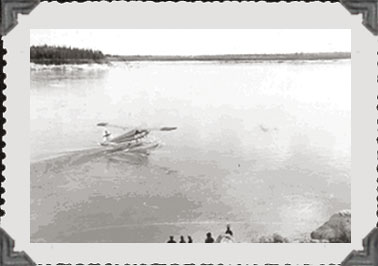
Bush plane
Fort Providence's population was sparse, but was comprised of an interesting
mixture. The three to four hundred Natives of the Slavey band, as
in all communities, ran the gamut from highly respectable to quite
disreputable. The RCCS establishment consisted of five or so men,
plus dependants; two RCMP constables - the local detachment - occupied
a compound of their own. A "white trapper," Sandy Davidson,
lived during the summer months in a cabin facing the river, just outside
the Signals compound fence.
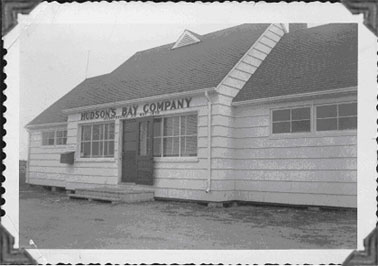
HBC Post
The Hudson's Bay trading post, except for a Native trader, comprised
the entire shopping district of Fort Providence. It was usually run
by a married manager with a young family, although at times by a bachelor.
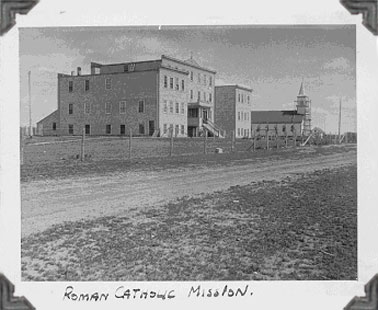
Roman Catholic residential school and church
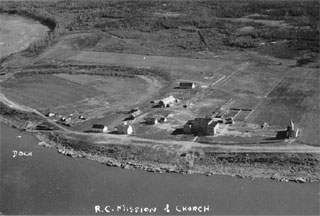
(L to R) dock area, Oblate Fathers' residence,
farm and
farm buildings, residential school, RC Mission Church.
The local RC mission
residential school pupils were taught and looked after by about a
dozen Grey Nuns and three Oblate Fathers, the latter acting also as
parish priests.
One of the Grey Nuns, Sister Lemire, a trained nurse, was allowed
to leave the residential school to treat any inhabitants who needed
medical assistance. In an emergency, she was able to obtain medical
advice from the government doctor by radio. He was stationed in Fort
Rae, at the end of the North Arm of Great Slave Lake, and visited
Fort Providence monthly. Sister Lemire was a jewel, and a tremendous
help to all the families of the settlement. The other sisters seemed
to be confined to the mission school premises and served as teachers
and housekeepers.
The Oblate Fathers
preached their Sunday sermons in three parts, in French, English,
and Slavey. Slavey is a difficult language for the non-Native. According
to the local Natives, the unfortunate fathers unwittingly said some
quite appalling things when they got to the Slavey section. This perhaps
provided an incentive for some of the congregation to attend church!
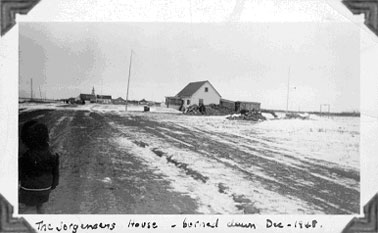
Temporary Quarters
Staff Sergeant Jorgy Jorgensen's wife, Joyce, and their little boy,
Kenny, were leaving to visit her parents in England on our plane's
return flight two days later. The Jorgensens had kindly volunteered
to lend us their house during her absence. Jorgy would batch it with
the boys in the single quarters until our quarters were finished building
and we could move in. The Jorgensens' frame house was heated by an
oil-fuelled space heater on the ground floor and also by a furnace,
which I think was wood-burning, in the small, dirt-floored basement.
Five weeks after we had arrived in Fort Providence, on September 17,
1948, our completed quarters were finished and we were able to move
in. Jorgy then returned to his own house, but in December his house
caught fire. Sadly, in spite of valiant efforts by all, it was impossible
to save it. Joyce Jorgensen and her son never did return to Fort Providence.
Jorgy went back to the single quarters and in the following April
was reposted. Dick then took charge of the station.
Living in Fort Providence took one back to the days of the early settlers
in Canada, and one could not help developing an enormous respect for
the pioneers. In Jorgy's house, as they had done, I also cooked on
a wood stove. This was a real challenge for me, particularly in getting
the oven to the right temperature for baking bread and pastry. Lighting
it and cooking on the stovetop were not difficult, though. After the
stove had been lit for a while, it was convenient having a small supply
of hot water on hand from its little side tank.
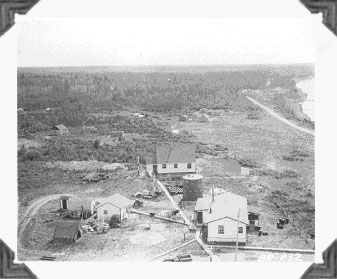
For Providence RC Sigs compound:
left to right:
outhouse, tent (building supplies), refrigerator unit,
PMQ, oil tank, single quarters
The Sigs compound, enclosed within a wire fence, contained, as well
as our completed permanent married quarters, several other small buildings
including the single quarters, the radio station, and the engine house
containing the Lister and Waukesha engines that powered the generators
providing electricity to the compound. It also contained a building
for the "reefer" (refrigerator unit), a garage, and a two-hole
outhouse. Boardwalks connected all the buildings.
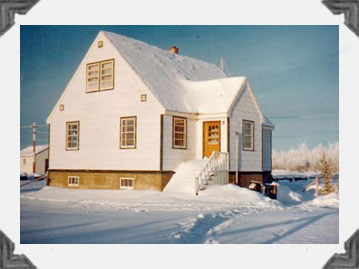
Permanent married quarters
[Next
Page]
Pages: [1]
[2] [3] [4]
[5] [6]
[7] [8]
[9] [10]
[11] [12]
[13] [14]
[15] [16]
Return to top of
page
Return to the Watts
Family page